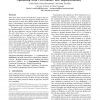Free Online Productivity Tools
i2Speak
i2Symbol
i2OCR
iTex2Img
iWeb2Print
iWeb2Shot
i2Type
iPdf2Split
iPdf2Merge
i2Bopomofo
i2Arabic
i2Style
i2Image
i2PDF
iLatex2Rtf
Sci2ools
ASPLOS
2015
ACM
2015
ACM
Asymmetric Memory Fences: Optimizing Both Performance and Implementability
There have been several recent efforts to improve the performance of fences. The most aggressive designs allow postfence accesses to retire and complete before the fence completes. Unfortunately, such designs present implementation difficulties due to their reliance on global state and structures. This paper’s goal is to optimize both the performance and the implementability of fences. We start-off with a design like the most aggressive ones but without the global state. We call it Weak Fence or wF. Since the concurrent execution of multiple wFs can deadlock, we combine wFs with a conventional fence (i.e., Strong Fence or sF) for the less performance-critical thread(s). We call the result an Asymmetric fence group. We also propose a taxonomy of Asymmetric fence groups under TSO. Compared to past aggressive fences, Asymmetric fence groups both are substantially easier to implement and have higher average performance. The two main designs presented (WS+ and W+) speed-up workloads und...
Related Content
| Added | 16 Apr 2016 |
| Updated | 16 Apr 2016 |
| Type | Journal |
| Year | 2015 |
| Where | ASPLOS |
| Authors | Yuelu Duan, Nima Honarmand, Josep Torrellas |
Comments (0)

